
Email Marketing
Use Email to generate more Sales from your eCommerce site (without spending more on ads)
This article is divided in two sections. Click here to jump to Part 2
Email predates all online marketing channels in use today.
Long before marketers tried their hand at selling through social media or search engines, the only tool in their arsenal was email.
Rudimentary versions of email have been around since the 70s.
However, it wasn’t until the early 90s that modern email systems (as we recognize them today) hit the market with the introduction of Lotus Notes and Microsoft Outlook.
And with Hotmail entering the fray in the mid-90s, the marketing world had changed.
Email allows you to directly send extremely personalized messages to a potential customer.
Twenty years later, email has amassed a tremendous reach and become more powerful than ever before.
Today’s marketers can segment their contact list down to the finest-grain and setup automated behavioral-linked triggers to send the right email to the right individual.
As an online retailer, this means winning new customers and bringing back existing customers to purchase from you again.
In this 2-part guide, you’ll learn the fine art of email marketing in the modern age.
First, I’ll show you the blueprint to high-performing eCommerce emails and then dive into how you can use it to make more money than you imagined was possible.
The Overwhelming Benefits of Email in eCommerce
When it comes to sales conversion rate, email is king.
Ecommerce email marketing accounts for 7% of customer acquisition which is second only to search. All other channels barely even register.
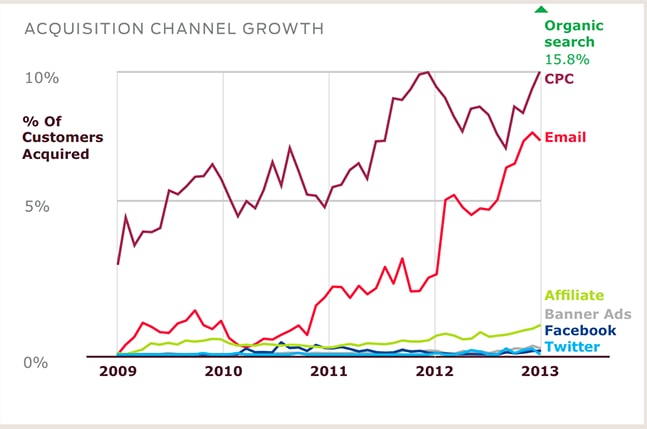
Receiving promotional material and special offers fuels this growth.
Research has shown that 72% of customers prefer email as a means to stay in touch with brands they like and a further 38% are drawn by the discounts offered.
It’s safe to say, people ‘latch’ onto ecommerce emails.
As a store owner, you know that acquisition is just part of the story.
Retention and customer lifetime value are critical for your bottom line. Again, eCommerce email marketing performs and delivers results on this front.
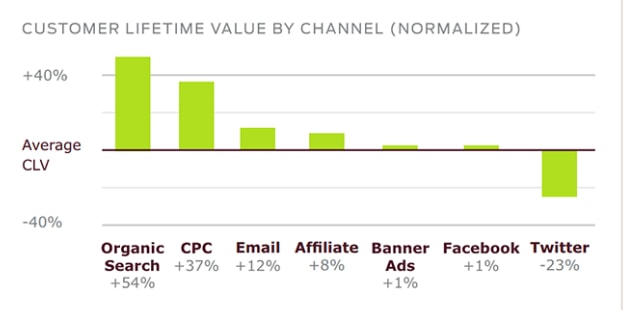
How Email Fits Into Each Stage of the Buying Lifecycle
I’ve already hinted at the different stages of a customer lifecycle.
In ecommerce email marketing, we can divide buyers into three categories: prospects, existing customers, and lost customers.
Here’s a graphical representation that can be applied to any industry:
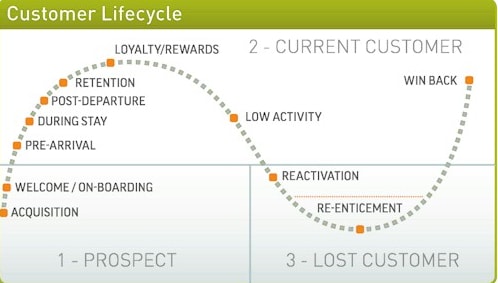
Email helps you move people through these stages by strengthening relationships.
If you focus all your attention on sending promotional email blasts while ignoring lead nurturing, customer retention and ‘win-back’, you’ll fatigue your customers and won’t have much success.
You need to oil the entire machine, add value and nurture your relationship.
Think of it like owning a car.
If you want to consistently get from point A to B, you need to regularly check your car’s oil level, tire pressure, and make sure there’s enough fuel in the tank.
You can drive a customer into the ground faster than an old Jetta if you don’t take care of them.
Alright, let’s get right to it.
Section 1
What Makes A Great Ecommerce Email?
A great email requires all components to function and perform simultaneously.
For example, a compelling subject line may get a reader to open your email but if it comes with a bad call-to-action (CTA), no one will buy from you.
It’s important to make sure your email looks good, reads well, and provides a clear benefit to readers on the first read.
Let’s look at elements that demand your attention:
1. The ‘From’ Name
The ‘from’ section informs users who the email is from.
Almost half of all emails today are spam. This makes the name you display in the from section important: you don’t want to sound questionable and be written off before the recipient even sees your message.
Make it easy for readers to figure out exactly who the email is from. Keep it simple and go with your company name.
ModCloth and Jackson & Perkins do this exceptionally well.
Take a look:


Remember to be consistent. If you’ve sent one email with your brand name, don’t change it up and use another name in future emails.
Don’t use an employee’s name in this section (unless your brand revolves around a person).
There’s no need to personalize just yet.
2. The ‘From’ Sender Address
When a user opens an email, right next to the sender’s name is their email address.
Here’s an example from FiftyThree:

Notice the “noreply@fiftythree.com”?
That’s the sender’s address. You want to avoid using noreply when you send out emails for a number of reasons.
First, it’s likely to get caught up in the spam filter. If that doesn’t happen, the email copy sends a negative vibe that doesn’t foster an environment of openness or dialogue.
Your email address should let users know they can reply (even if emails are automated).
This creates a better user experience and improves engagement rate as it’s easy for people to reach out to you when they have a question.
Zapier does an excellent job promoting open dialogue with this simple sender address.
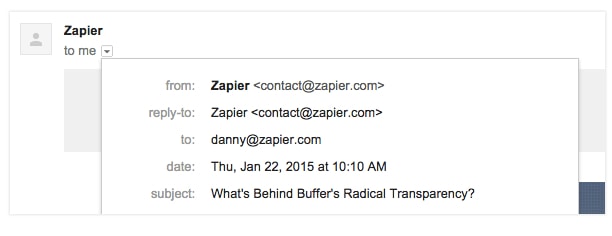
When you help solve problems, people are more likely to buy from you.
Generally, hello@yourdomain.com and contact@yourdomainame are good choices.
Otherwise, you can try your luck with the following:
- Match your email ID to your from name
Matching your sender address to the name you use in the from section serves as an extra layer of trust.
Notice how Underarmour’s sender address mimics the sender name.
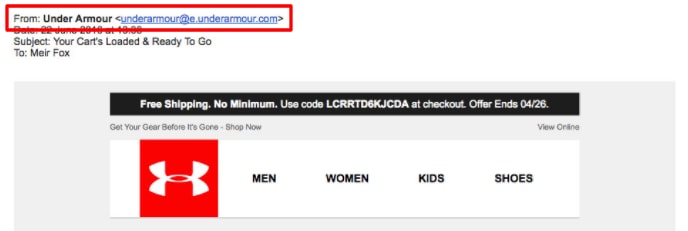
- Personalize email ID for the purpose
If you’re using an email ID for a specific purpose such as sending newsletters or offers, you can customize
For example, check out Michael’s sender address for an email that provides coupons:

JetBlue does something similar for providing customer support:

3. The Subject Line
Subject lines receive a lot of love when it comes to email marketing.
This is because they have a big impact on the outcome of your email campaign. When users receive an email, they spend most of their time looking at the subject line.
In fact, subject lines have the most impact determining the success of your email campaigns.
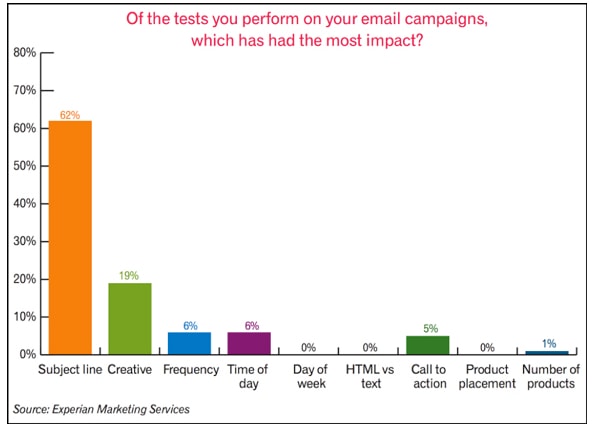
Since subject lines are the first thing people notice, take the time to get them right.
They need to communicate why someone should open and read your email. You need to make subject lines relevant, appealing, and informative.
Here are a few tips to get you started:
- Keep it simple
People have a habit of scanning text.
The shorter your subject line (<50 characters), the easier it will be to scan and take away your unique selling proposition.
Notice how most of the subject lines in this sample inbox are concise.
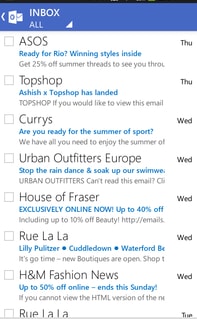
Make sure to test your subject lines for simplicity by using the 4-second rule.
If it doesn’t lead to an open within 4 seconds, you need to try an alternative subject line.
- Avoid spam trigger words
Every other eCommerce store is trying to sell their products.
In doing so, they resort to words such as ‘free’ or ‘percent off.’ They may also use money symbols or caps to highlight an offer.
Rather than enticing opens, all you accomplish is setting off spam alerts on email clients, and disregard from your intended audience.
Email services such as Gmail will automatically route these emails to the “Promotions” tab in a user’s inbox which may never be seen.
Dixie Horse & Mule Co’s subject line seems super spammy.
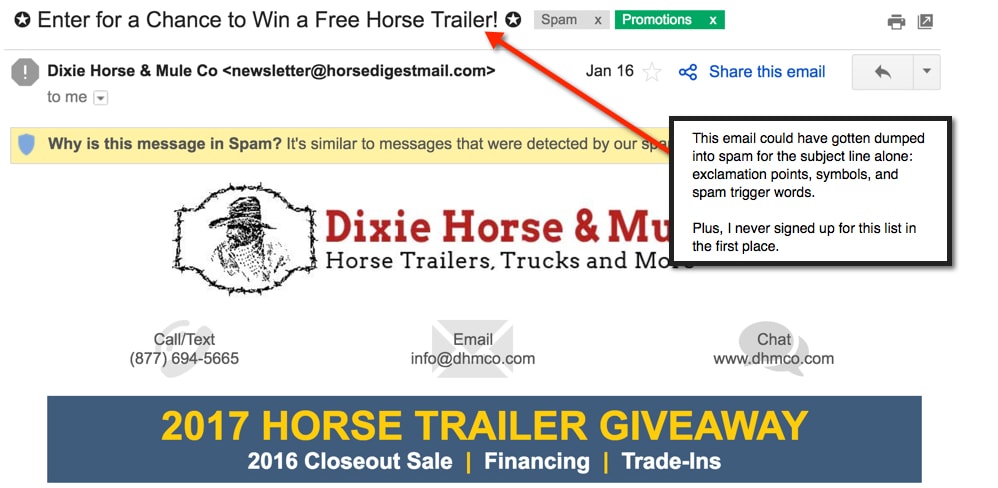
While you can be promotional occasionally, be mindful and avoid using overtly sale-focused language and symbols in the subject line.
- Target people’s inherent fears
Low supply, high demand.
People act predictably when scarcity exists (whether natural or artificial). Purchases are more likely to occur when there is an element of fear of missing out on a product or deal.
Sprinkle in some urgency into your subject lines.
Minted does this really well, keeping it short while conveying urgency:
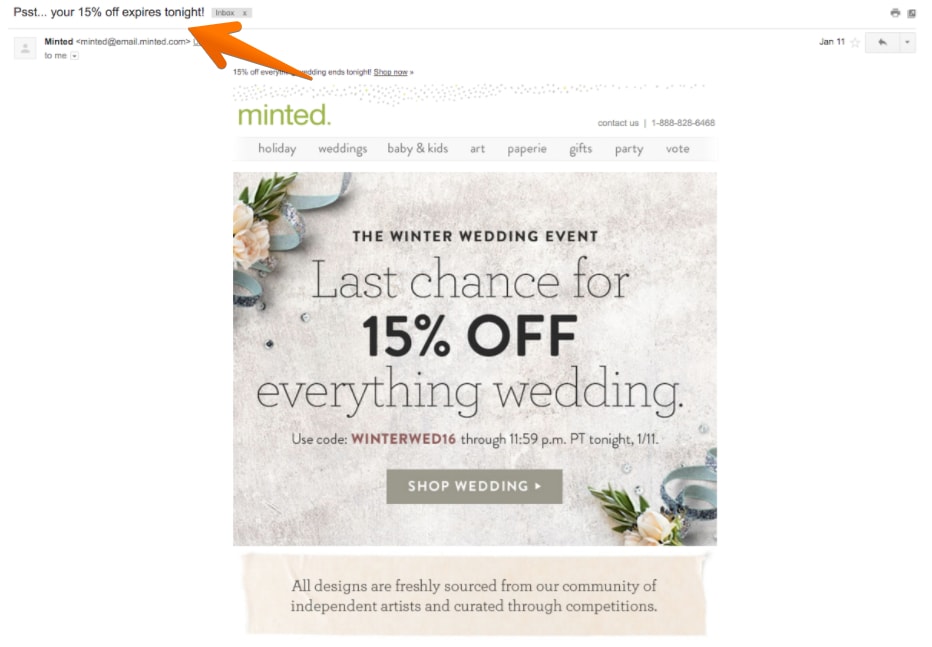
Again, be careful not to over-do it. If every subject line you send alludes to urgency, users will soon catch on and stop believing you.
- Personalize
Email is a uniquely one-on-one medium.
When a person receives an email, they expect it to be tailored for them. To most marketers, this means mentioning the recipient’s name.
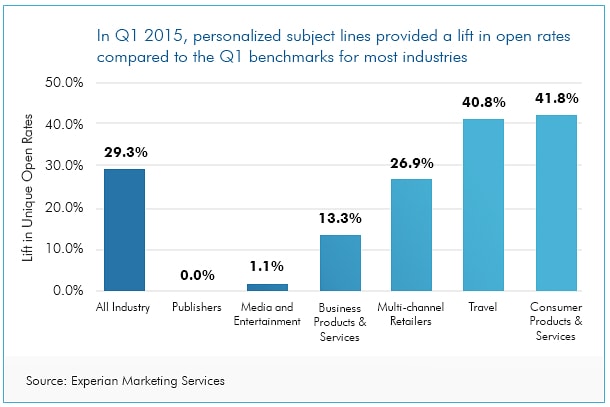
Unfortunately, everyone is doing this now.
To stand out, try personalizing subject lines based on location, gender, or level of brand loyalty shown.
Or consider mentioning a specific product that the recipient has shown interest in.
- Never stop testing
You can read all about subject line theory, but reality doesn’t always fit with theoretical models.
Use these tips as a starting point to create your subject lines.
Then test and tweak constantly to optimize your results for maximum impact. Track your open rates and run A/B tests to identify what works best for your particular audience.
A few more things…
Before we move on from subject lines, I want to point out a few things.
Always mix up your subject lines. Don’t repeatedly blast the same type of emails as this decreases engagement over time.
Instead, mix things up.
If you send the same kind of message frequently, keep an ongoing list of variations that you can use, or consider structuring your message as a recurring email to allow your recipient to quickly identify that the email includes familiar content.
A recurring email is the one exception to the “don’t use the same subject line” rule.
Also, don’t mislead your audience.
Your email should exactly match with what your subject line hints at.
A misleading subject could increase your open rate but at the expense of customer trust. When recipients feel duped, they aren’t going to turn around and spend money with you.
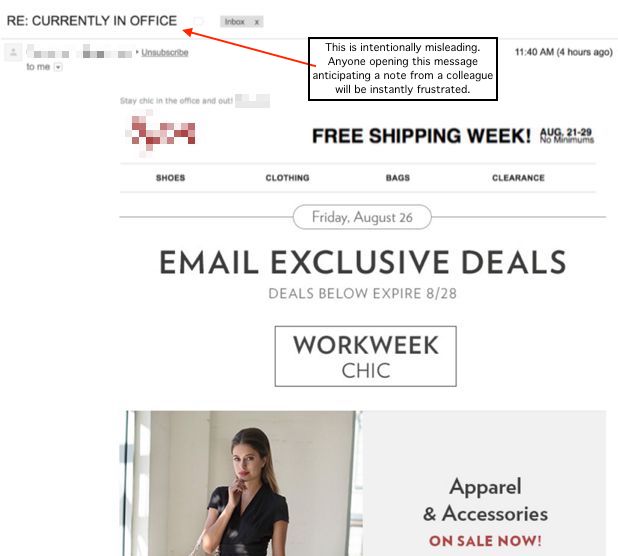
Once your subject line is ready, head over to Coschedule’s Headline Analyzer or SubjectLine to test its battle readiness.
If you want to read more about subject lines, we’ve covered the topic extensively in this post.
4. Pre-Header Text
The preheader, sometimes referred to as preview text, is a short summary text that follows the subject line in most email clients.
It allows you to provide a preview of the content contained within your email to readers before they even open it.
Here’s how pre-headers look in Gmail:

In other words, your preheader is a continuation of the subject line.
These two components need to work together to pique interest and get emails opened.
Combinations that ramp up curiosity or improve the level of emotional connection with your brand always perform well.
Notice how men’s clothing line Topman uses both elements to initiate a conversation.

You can even include a CTA to increase open rates.
Joanna Wiebe makes the next step she wants her subscribers to take crystal clear and helps them take that action.
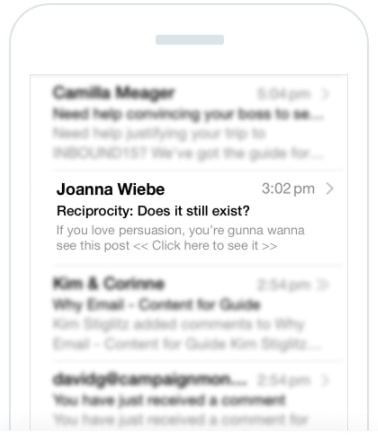
Other factors worth considering in your pre-header text include:
- An irresistible offer
- Urgency
- Communicate your value add
Like your subject lines, you have to consider the length of your pre-header text.
Since email clients have varying character limits, don’t make your pre-header lengthy.
Here’s a visual breakdown of the differences you need to be aware of.
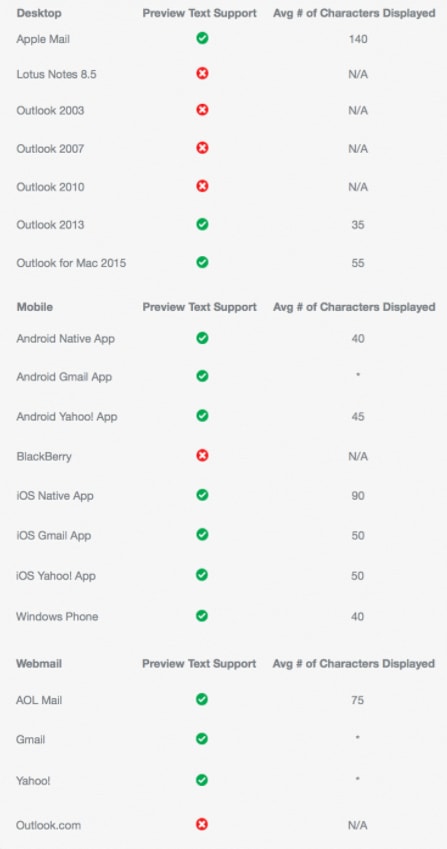
Limiting your pre-header text to 40-50 characters is a safe bet to ensure nothing gets cuts off regardless of device and email service used.
Lastly, you should always test how the pre-header visually affects your email.
The pre-header text doesn’t just appear next to the subject line but also in the beginning of the body of your email (once the email is opened).
If it detracts from your core content too much, hide pre-header text in the body of emails.
Compare how Converse’s original email reads against the improved version.
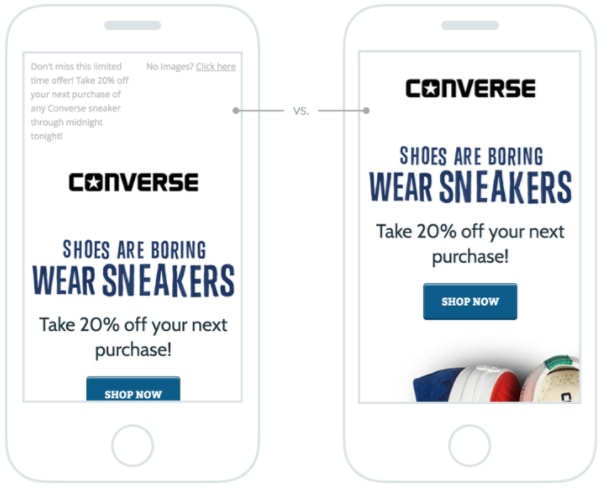
Now That Your Emails Are Being Opened…
Take a few moments to give yourself a pat on the back.
Getting people to open your email is the hardest part of this process. However, don’t celebrate just yet because there is still work to be done.
5. The Email Body (Copy)
Your email copy should stimulate readers to think and act on one conversion goal.
To do this, focus your message on a single audience rather than your entire email list.
For example, a floral store with a stock of new roses might segment their list to target men who buy roses for their partners.
Let’s break down:
- Be Concise
Using large chunks of text and/or lengthy sentences is a strict no-no.
You want to quickly make it clear why you’re emailing someone and the best way to achieve that is with clear, concise, and easy to read copy.
Take a look at this email from CanvasPop:
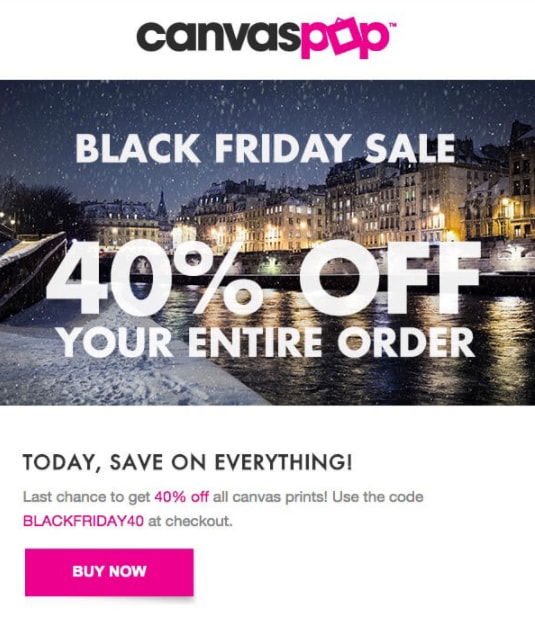
It only takes a few seconds to figure out why they have emailed you.
It’s easy to read and doesn’t try to hide what they actually want you to do after reading it.
- Be conversational
Make sure your emails are fun to read and have some personality.
Being one-dimensional and using the same copy will bore readers. Keep things fresh by telling a story, sharing mistakes you’ve made, or using personal anecdotes to grab attention.
Huckleberry’s Black Friday email does this superbly.
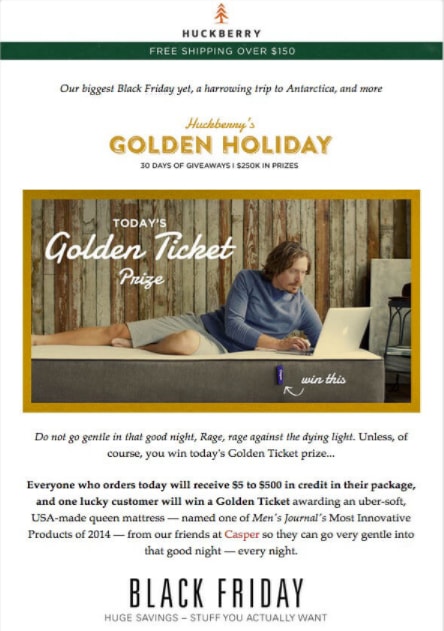
Why is this email so good?
It’s different from most other Black Friday emails that just offer generic discounts.
Instead, it creates excitement around its promotions with engaging copy.
- Add urgency
Just as with your subject line, make sure that your emails themselves include motivation to act now.
Procrastination is inherent in human nature.
If your recipient feels they can put off acting on your offer or call to action for a week, or a month, the email will languish in their inbox until it is inevitably forgotten and eventually swept off to the trash folder.
6. The Email Body (Design)
If your emails read like an ad, recipients will tune out.
Emails should be designed to get readers to your store quick as possible. A clean simple design should be given priority of overly complex layouts that keeps readers lingering.
Match the design (and copy) of your email to the intent of your readers.
For example, if you’re just looking to sell a product (or announce a sale), a high-quality image with few words will get the job done.
If your product is complicated, invite readers to click on a landing page to learn more.
Here are a few points to keep in mind:
- Plan for no images
Many email clients block images unless a user manually opts-in to see them.
Data analysis from Google indicates that image blocking affects 43% of emails.
When designing your email, think about how your message would look if the images were turned off.
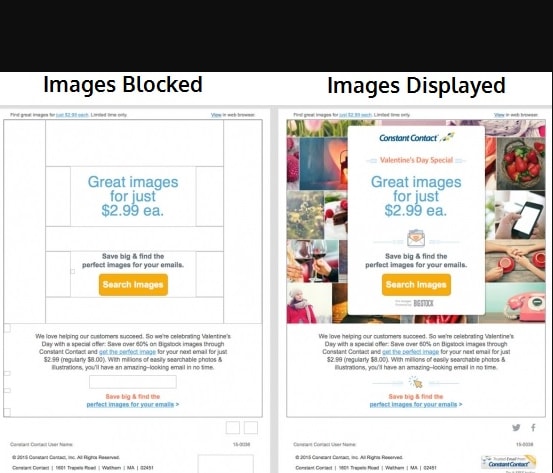
Avoid embedding critical content within images – this includes your CTA.
If you must, include alt tags to help readers follow along.

- Make images impressive
If readers are able to see images, you need to engage them with stunning visuals.
Use high-quality photographs to help potential customers ‘experience’ the product. If you can place the product in context, showing how they can use it, even better.
Check out how Bridal Photographer incorporates this powerful image:
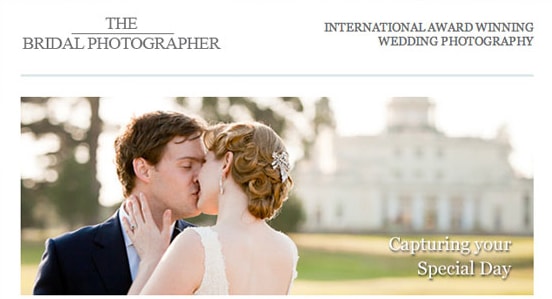
Use images to be eye-catching, informative and/or build emotional connections (as in Bridal Photographer’s case).
- Limit everything within 600px
There’s nothing more annoying than having to scroll left to right. Well, maybe pineapple on pizza, but we’ll let that debate rage on!
If your email requires horizontal scrolling, content that’s not initially in the frame of sight will likely be overlooked. People aren’t reading a book here.
Eye-tracking studies show people scan content, so facilitate that habit.
- Make your email mobile-friendly
With more and more emails being opened on small screens, they should read well on mobile devices and tablets.
This is easy to do with responsive email design.
Designing your email in this format will ensure that your email dynamically adapts for ‘best-viewing’ regardless of which device readers are using.
Women’s fashion brand Ardene’s emails look equally good across all platforms.
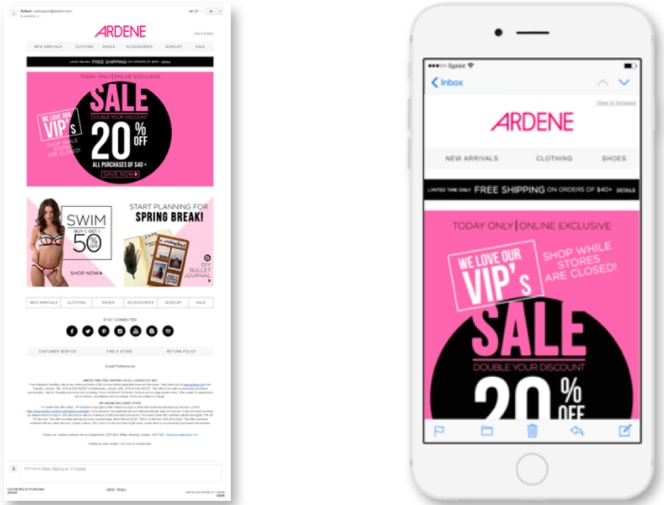
- CTA that’s easy to spot
Include at least one CTA – multiple if your email requires vertical scrolling – so your readers know exactly what you want them to do.
Make them large and make them appear clickable.
As soon as they see it, readers should want to click on them to continue with their journey.
Also, your CTA must link to the right page.
For example, if you want them to buy a specific product, your CTA should take them to your product page instead of your home page.
You don’t want a convinced customer to have to hunt through your site’s navigation.
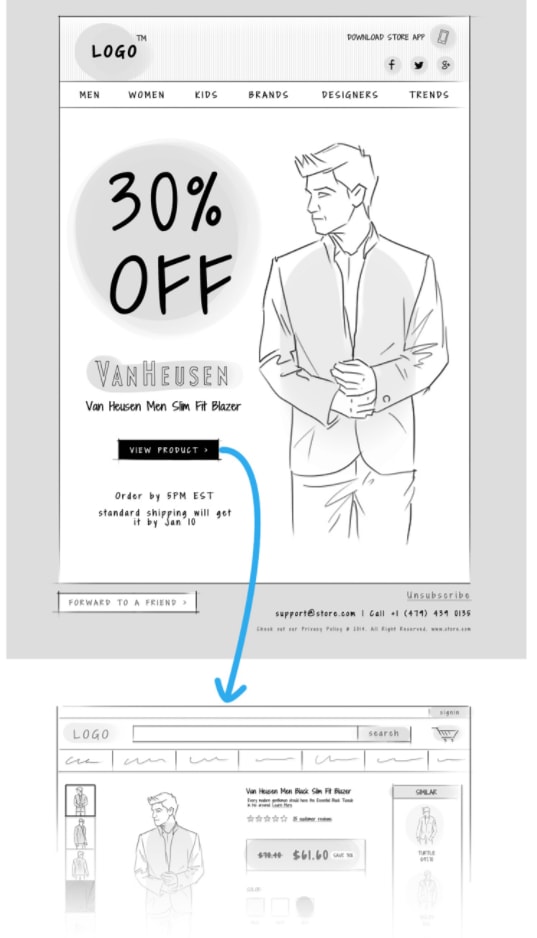
But wait, there’s more!
Ready to get cracking on crafting an epic eCommerce email? Not so fast!
It’s not all about sales and promotions.
To ensure that your emails don’t get relegated to the “unsubscribe” vault of sadness, you need to prepare a variety of campaigns that go beyond coupons and deals.
In Part II of our epic guide to eCommerce email marketing, we’ll show you how to build your email arsenal to ensure ongoing customer engagement and long-term buyer loyalty.
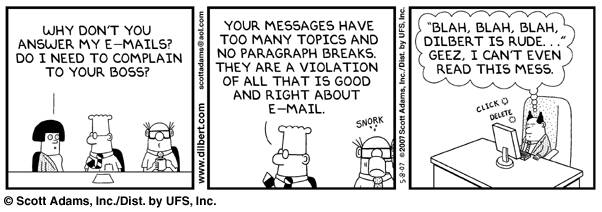
Part 2
Click here to go back to Part 1
Now that you’ve had a crash course in how to craft emails that will get opened, read and acted upon, it’s time to consider the kinds of emails you need to create.
That’s right: it’s not all about sales and promotion emails.
Sending email blasts without any strategy is ineffective no matter how well-designed your emails are.
Since no two customers are alike, you need to spend time and personalize your message.
To start, think about the different stages in a customer’s purchase lifecycle and segment your email list accordingly.
We’ve broken the process down into 3 stages:
- Stage 1 – Potential & first-time buyers
- Stage 2 – Repeat buyers
- Stage 3 – Lapsed buyers
Based on this information, you can target customers using specific email campaigns and triggers at each stage to increase the likelihood of conversion.
For example, you might have one email series that focuses on gaining a reader’s trust to win their first purchase while another may incentivize existing customers to buy from you again.
What’s great is that you can automate most of these emails.
Here’s how to turn your emails into an invisible round-the-clock sales team.
Stage 1 – Potential & First Time Buyers (Interested)
Most people take time to make a purchase.
Studies show that 98% of visitors won’t buy on their first visit to an eCommerce store.
They may be interested, they may have even given you their email, but that doesn’t mean they aren’t shopping around and considering your competitors.
Only you can convince them as to why they should spend on you rather than anyone else.
This is your opportunity to make a great impression and secure sales.
Spend the time to welcome potential customers into your family, establish a link to your brand culture and nurture them towards an eventual purchase.
1. The Welcome Email Series
The welcome email is the first exchange between your business and a potential customer.
While often overlooked, data overwhelmingly suggests that you should take the time to treat customers as humans rather than a statistic used for profit.
74% of consumers expect a welcome email and as a result, you can expect 4 times more opens and 5 times the click-through rate of other promotional emails.
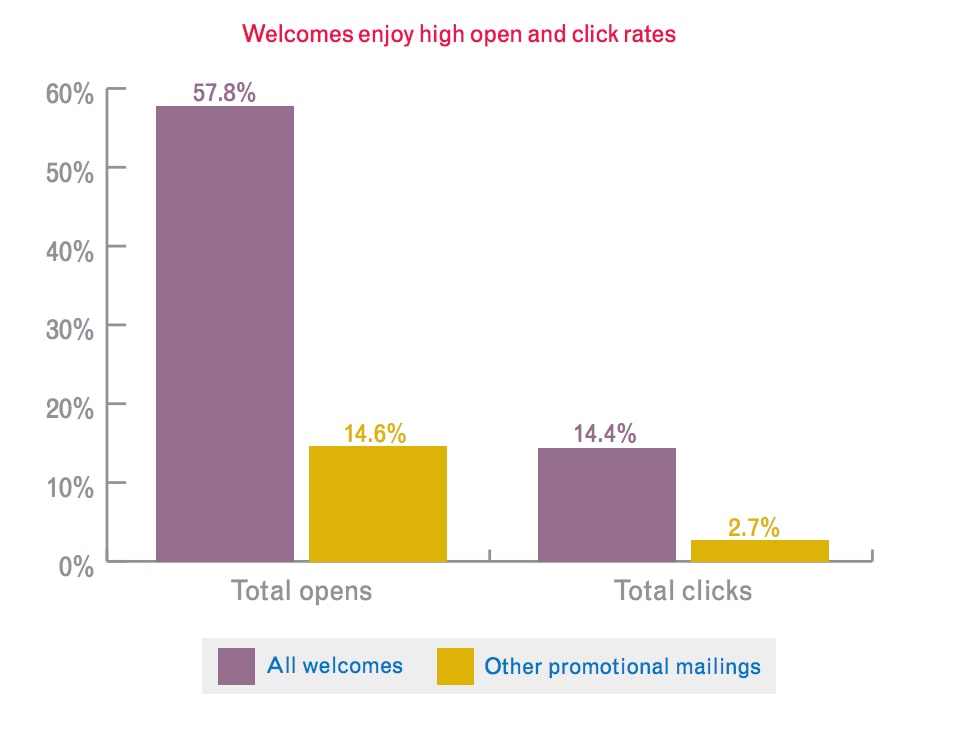
What makes a great welcome email?
The best welcome emails aren’t wordy. Rather, they include great visuals and do some (or all) of the following:
- Extend a big hearty welcome
- Define what makes you different
- Inform subscribers of what to expect next
- Make an offer
- Promote social profiles
Here’s a great welcome email from women’s clothing line Karen Millen:
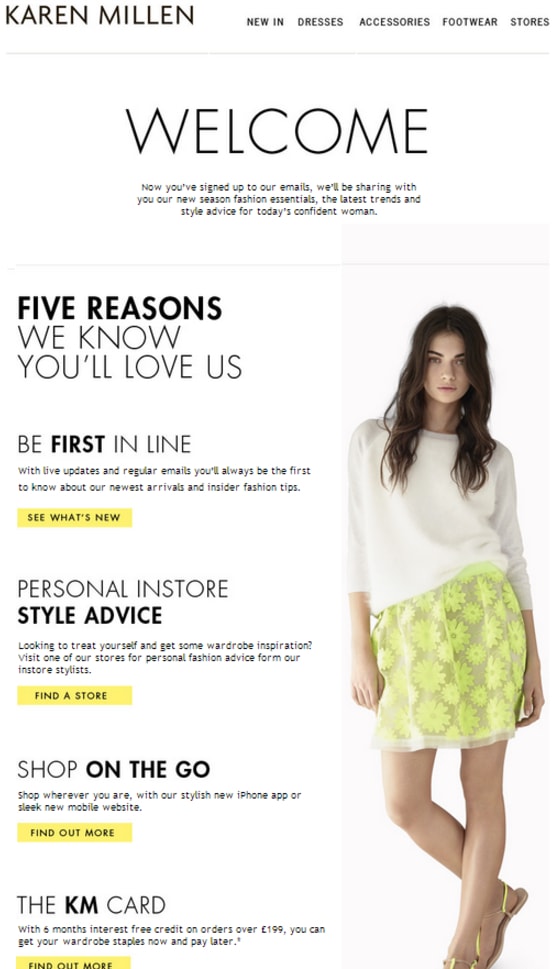
Hello! And Welcome to the Family!
The first thing readers should see is a friendly greeting.
This makes readers feel appreciated. Also, you’ll build trust if potential customers feel that you want to solve their challenges rather than just make a quick buck.
Test out phrases such as “welcome to the family” or “thanks for subscribing”
Virgin America uses a pun to brand their welcome message.
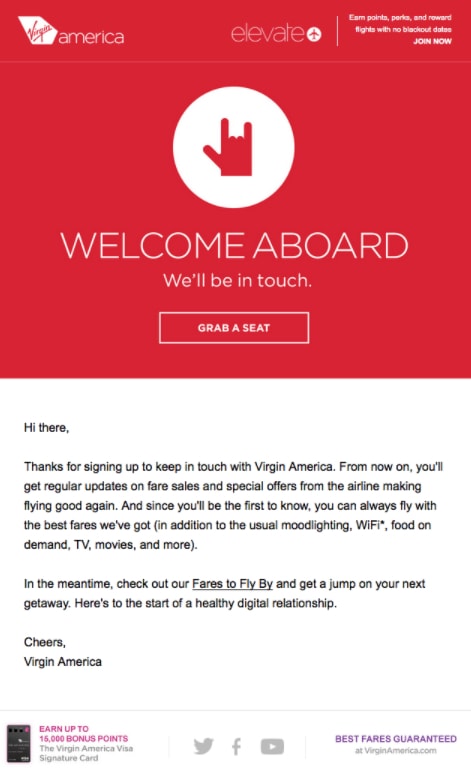
- Introduce yourself
Spend a moment telling potential customers more about you.
Share your brand story to let people know what makes you different or special. Identify the reasons why someone should shop from you rather than a competitor.
Food52 does this by letting readers know what motivates them.
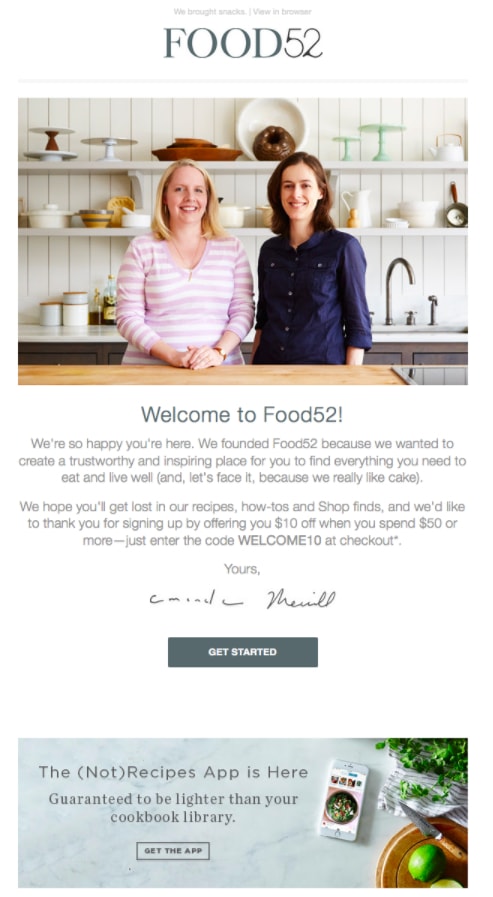
- Set expectations
Inform readers about the type of content (and frequency of emails) they can expect from you.
Sharing this information can be the difference that gets your emails into a reader’s inbox instead of the spam folder.
Gilt gives a clear direction of what to expect from them.
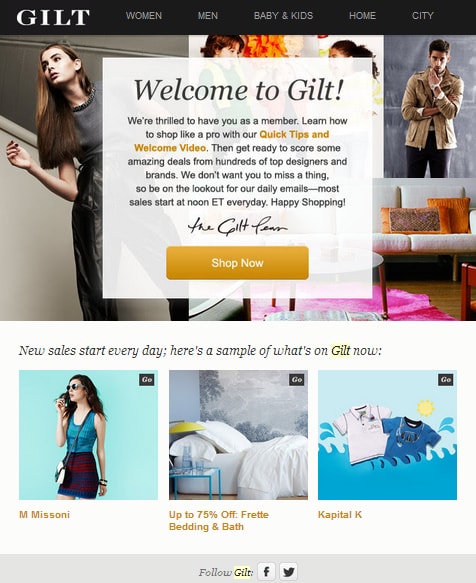
- Provide incentives
Incentives are a great way to get customers to act.
It reduces the level of risk associated with trying out your products. For first time purchases, this can help turn an on-the-fence window shopper into a loyal customer.
Renowned clothing brand Gap offers an incentive right away rather than indoctrinating recipients into their brand culture.
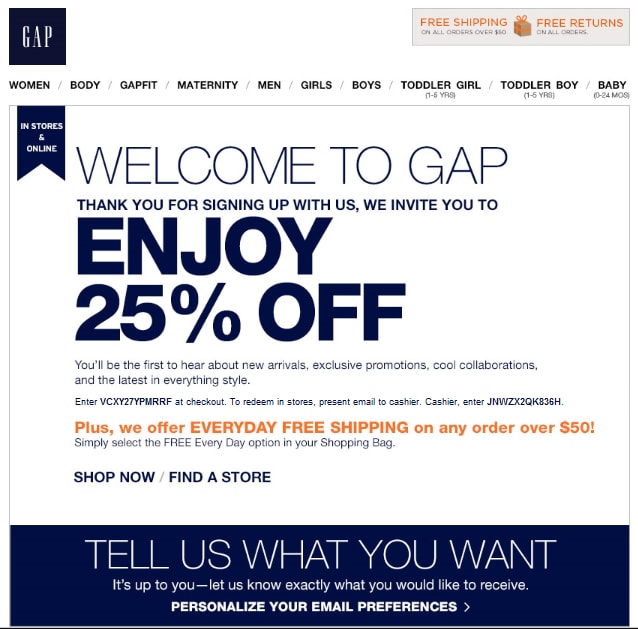
Incentives don’t always have to mean discounts.
You can try out free shipping options, a gift, or even redeemable brand bonus points.
- Get social
Though this should be low on your priority list, remember to add links to your social profiles at the end of you welcome emails.
Some customers that don’t love a cluttered email inbox might instead be inclined to interact on social media.
In fact, brands such as Glossier encourage readers to connect with them on social.
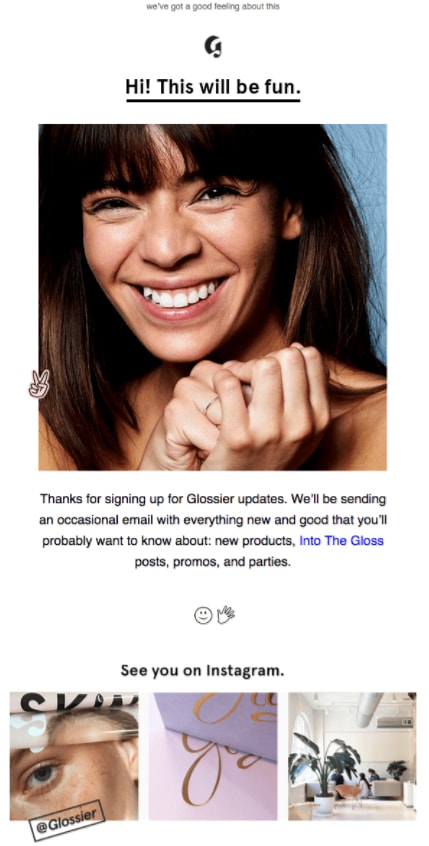
2. Lead nurturing email series
For some, a one-time welcome email will be enough to get them to buy from you.
However, a majority will still require further hand-holding. After you’ve sent your initial welcome email, the next few emails should work to warm leads until they are ready to buy.
It’s important that these messages remain non-promotional.
Instead, spend time to show that you understand the problems potential customers face.
When they’re ready to buy, you’ll be the first name that comes to mind.
If you’re wondering what a lead nurture email looks like, here’s a great example from Framebridge.

What can you do to make impactful lead nurturing emails?
- Educate
- Tell stories
- Entertain
- Education
Educational emails are alarmingly underused in eCommerce for a few reasons.
Many store owners feel it’s not possible to educate customers in their niche. If that’s not the case, they find it hard to create original, thought-provoking content.
Yet, this is a misconception.
Anyone can (and should) educate leads. Doing so provides you leverage as an authority and influencer in your niche.
We don’t have to remind you how people trust (and buy) from those perceived as experts.
Men’s grooming line Beardbrand uses education to not only help their customers solve challenges but also place their product in context.
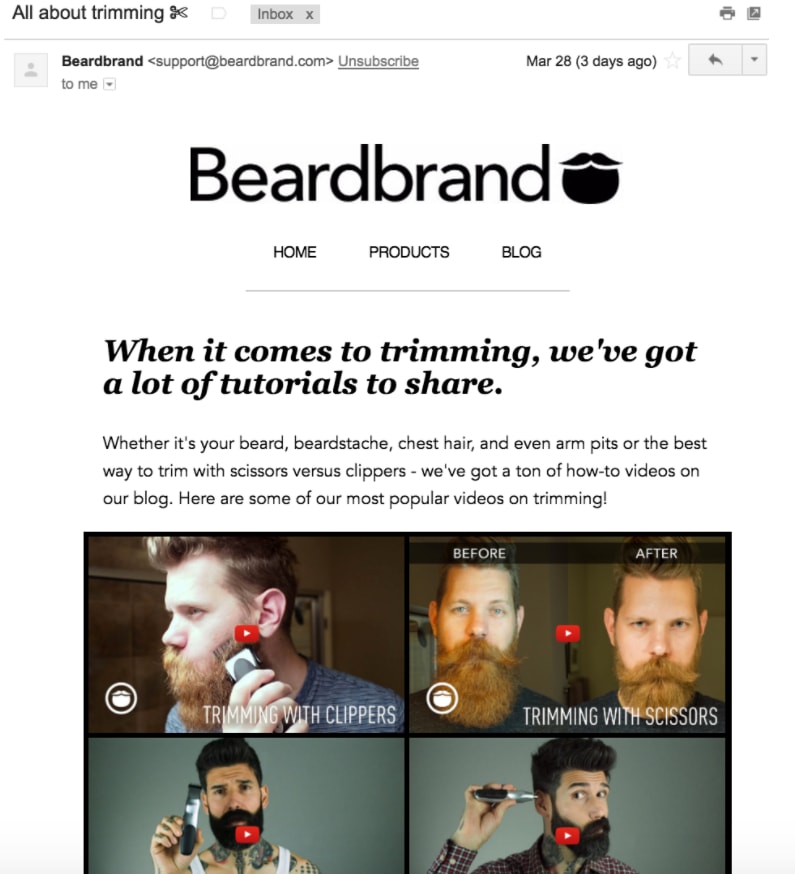
You’ll need to take the time to determine the type of content that aligns with your product and relates to your audience.
Ask yourself the following questions:
- Who are my customers?
- What do they care about?
- What problems do they have?
- Is there a way I can provide insight into that problem?
Once you answer these questions, brainstorm how you’ll deliver the answer.
For example, you might decide to create a video or detailed how-to guide. Perhaps you’ll provide a curated collection of links to existing how-to videos on YouTube or offer a checklist for a related activity.
Regardless of the route you take, remember to keep focus away from your products.
- Continue with your story
If you didn’t share your brand story earlier (or did so briefly), now is a good time go all out.
Talk about how your business got started and what drives it today.
Alternatively, you can share stories from your employees to humanize your brand or relate testimonials from existing customers.
Since shoppers can’t physically touch or see products, sharing reviews and testimonials from their peers is a great way to ease fears and continue winning their trust.
Huckberry spends time to let readers know exactly what they are all about.
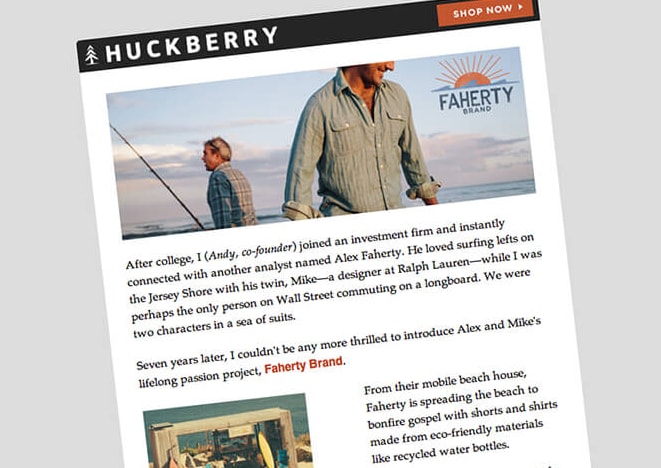
- Entertain your audience
Just because you’re sending automated emails doesn’t mean they have to sound like them.
People relate to a brand with personality. Infusing your email with something as little as a joke can help you build an emotional connection that sets you apart in their mind.
With purchase decisions driven by emotions, take time to win some hearts.
JetBlue sends lead nurture emails that are fun to read from start to finish.
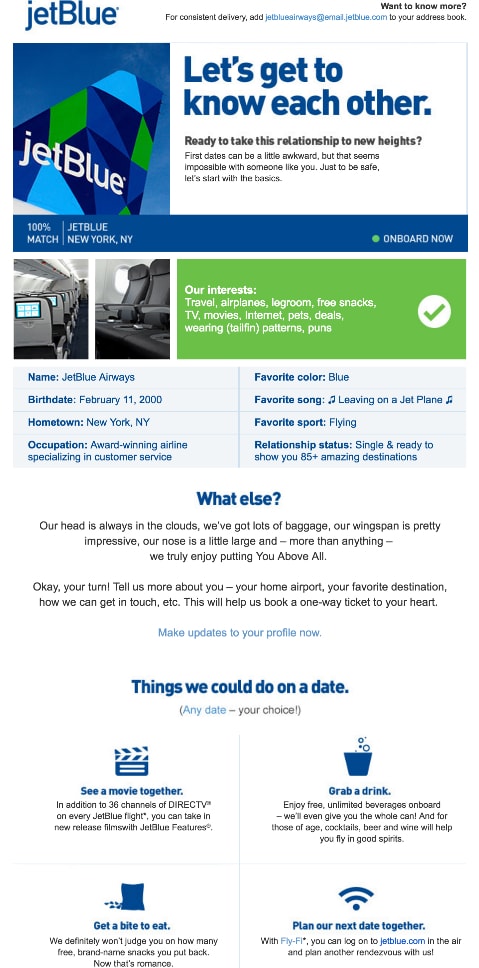
Your lead nurturing email campaign should have a defined timeline.
The optimal length will largely depend on your industry and target audience. Pay close attention to how you space your nurturing emails.
You need to be patient and not rush a sale.
For example, your timeline may look something like this:
- Day 1 – Welcome email
- Day 8 – Lead nurture # 1
- Day 15 – Lead nurture # 2
Each email in this segment should build up, or ‘soft-sell,’ your final offer. With the hard work of warming leads completed, there’s one thing left to do.
Sell.
All nurture campaigns should be capped off with a promotional email to ensure people make that elusive first purchase.
3. Promotional email series (for first-time buyers)
With readers at the end of their journey, it’s time to face the music.
Your nurturing campaigns should have convinced people to trust you. Now, nudge them over the finish line with an email that compels a purchase.
Here’s an example of a promotional email from Jet:
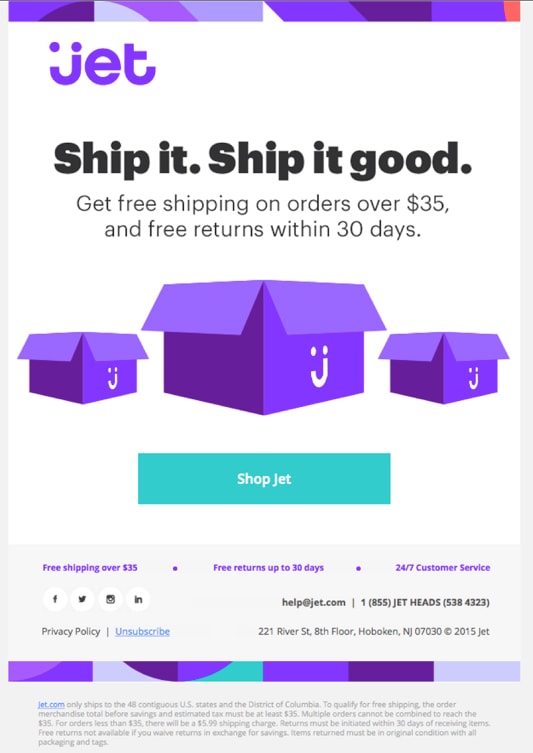
Here are a few types of promotional emails you can test:
- Coupon
- Browse abandonment
- Coupon emails
These emails are relatively straightforward.
All you do is offer the recipient a unique promo code that gives them a flat discount on any product they wish to purchase from you.
Because everyone loves a good bargain, coupon emails typically get the job done.
Check out this promotional email from lifestyle brand JOY:
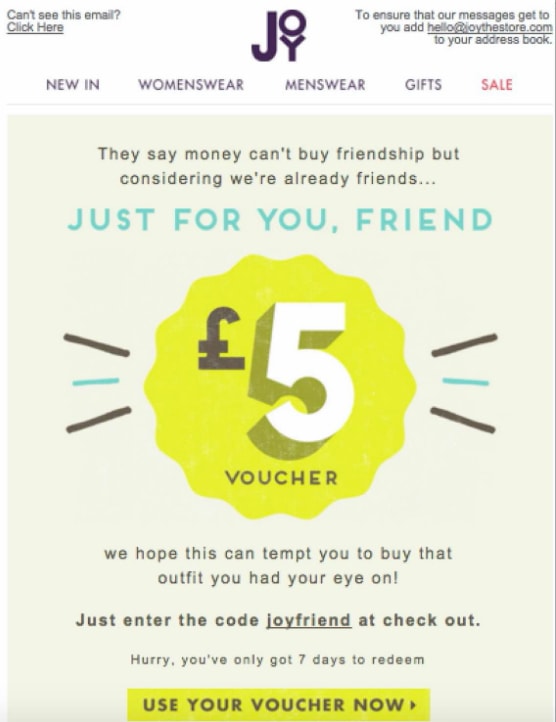
Including a reason for the offer like JOY has here improves your conversion.
They’ve gone step further and also set a time limit on their discount to make sure customers don’t delay action.
Note: As with most promotional offers, you can switch out a discount for free shipping, a free with purchase add-on, or bonus loyalty club points, just to name a few value-adding alternatives.
- Browse abandonment email
Instead of offering general discounts, you can send a personalized reminder.
Email marketing tools let you set up page triggers so that if someone visits a product page but doesn’t buy, you can send them a reminder about it.
Retail clothing brand PacSun sends reminders to shoppers based on the product category they browsed on their website.
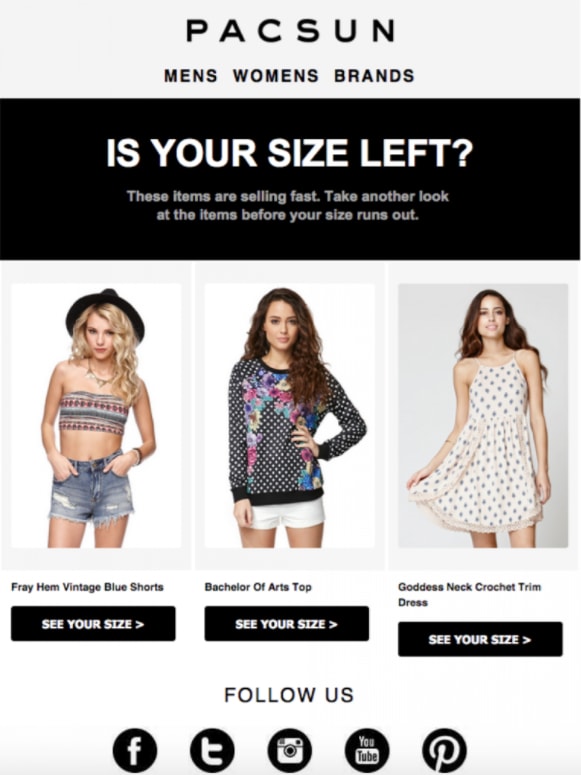
To make this even better, add a quick discount to fast-track purchase.
This is, of course, a close cousin to the cart abandonment email.
4. Cart abandonment emails
Technically, you can utilize these emails whenever a customer abandons a cart regardless of their previous purchase history with you.
For the sake of organization, I’ve included them in this section as this is where you’ll probably end up using these emails.
What exactly is cart abandonment?
It’s when shoppers add items to the checkout cart but for some reason never end up completing the purchase.
It’s hugely common for first-time site visitors to browse before buying.
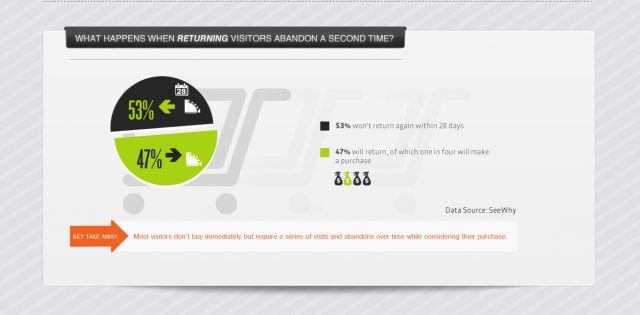
Between new site visitors and returning visitors, almost 70% of all shopping carts are abandoned.
But many visitors will abandon their cart with the intent to return (75% according to the statistic above).
If you don’t get cart abandoners back to your site, you’re realizing a very small percentage of your actual earning potential.
One study estimates that this phenomena costs online retailers $4.6 trillion in sales every year.
Rather than viewing abandonment as an unsalvageable loss, think of it as an opportunity. While you can’t fully recover every penny lost, you can win back some sales.
To design effective cart abandonment emails, you first need to understand why shoppers leave a purchase mid-process to begin with.
The reasons are many and varied:
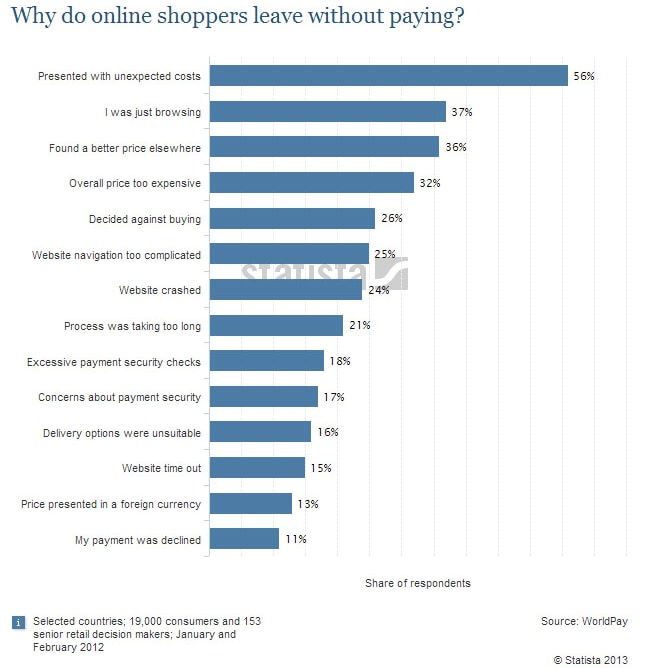
Unfortunately, you can’t be sure as to which of these reasons afflicts your potential customer.
At best, you can make a guess. A cart abandonment email series lets you address a variety of pain points and convince customers to return to complete their purchase.
- Time is of the essence
The first 24 hrs after cart abandonment occurs is vital.
72% of all customers who end up buying from a cart abandonment email do so within this time frame. Rather than requiring an incentive, they simply need a reminder.
As a result, your first cart abandonment email should simply bring back customers to checkout.
Offering a discount at this stage will unnecessarily eat away into your profits.
Chubbies Shorts makes this process fun and easy.
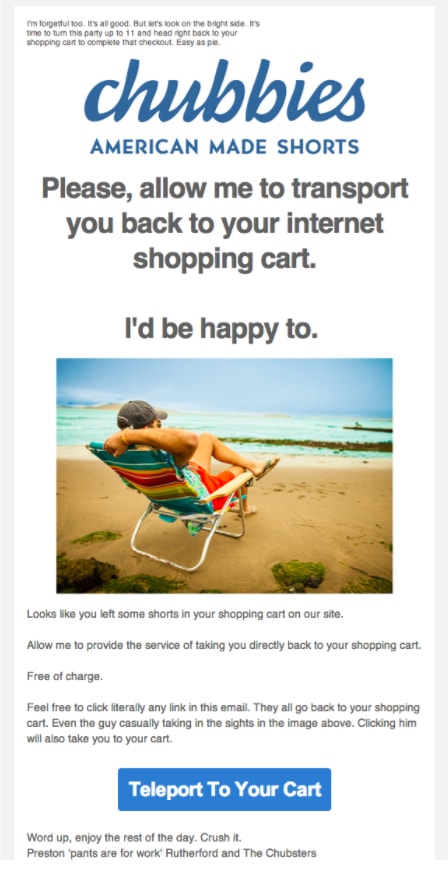
Keep the following points in mind while constructing these emails:
- Include a high-quality image of the product in question
- A link (CTA) that leads readers directly back to the checkout
- A way to reach your customer support in case they need help
- Take that reminder one step further
Next in the series of cart abandonment emails is an ‘advanced’ reminder.
In this email, state your value add as a company on top of your reminder. For example, you can remind shoppers that you offer free shipping or about your no-questions-asked guarantee.
Shoppers may have missed these points the first time around.
So take time to remind them about their cart and about how awesome you are.
ASOS’s cart abandonment email first offers a simple reminder about what’s been left behind and then mentions a few points that highlight how purchasing from them involves minimal risk.
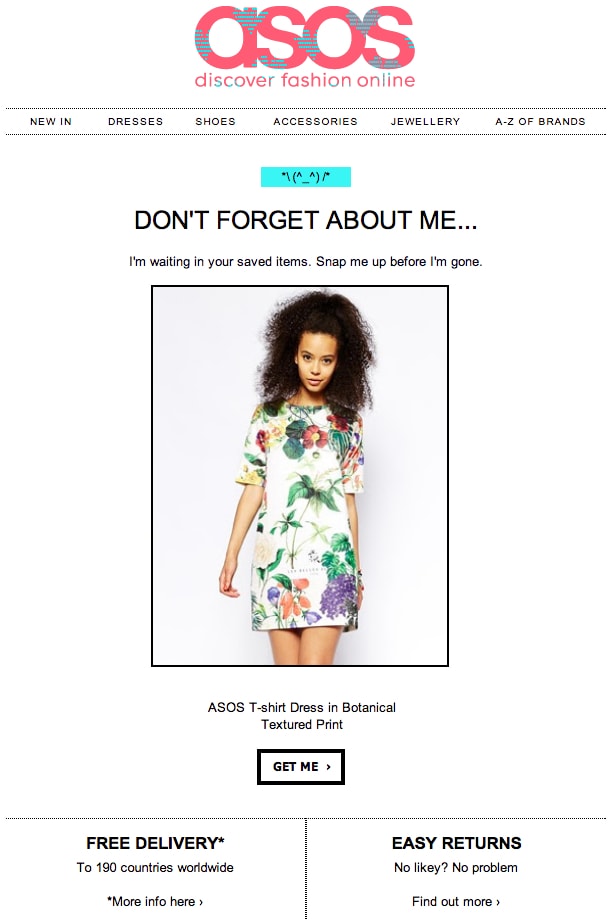
- The discount cart abandonment email
If none of the above emails work, your customers are price-sensitive.
It’s likely a discount will push them to complete a purchase. Consider how much loss you’re willing to forego in order to make a sale.
Generally, you’ll need to offer at least 10% if you want to see any results.
Don’t forget to add an element of urgency to your discount.
Levis cart abandonment email gets to the point quickly and it happens to work quite well.
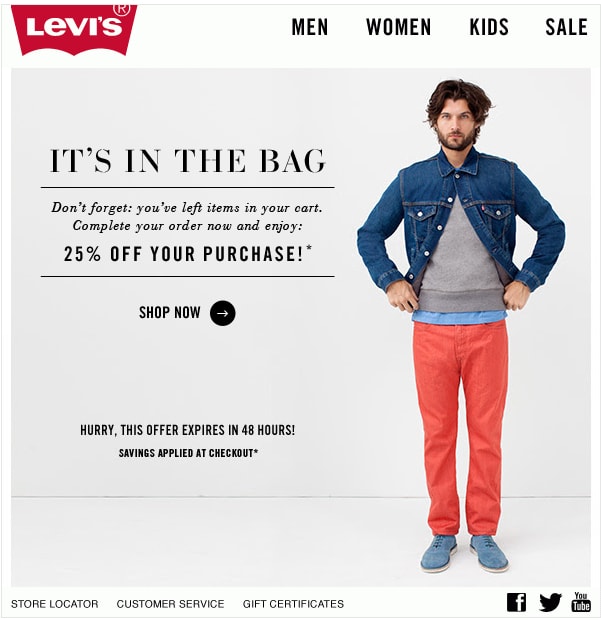
Stage 2 – Repeat Buyers (Engaged Customers)
With your first sale comes great responsibility.
The probability of selling to an existing customer is 60-70% compared to just 5-20% for a new prospect. It’d be foolish to disregard using email sequences for customer retention.
In fact, email beats out all other marketing tactics when it comes to retention.
40% of an eCommerce store’s revenue is created by 8% of customers. That 8% is repeat customers – they’re hugely profitable!
Yet eCommerce stores devote 80% of their budget to customer acquisition.
Alright, enough numbers.
Suffice to say that the bulk of your profits will come from getting customers who have bought from you before to buy again and again (repeat customers).
There are two types of existing customers:
- Fresh customers
- Occasional customers
Let’s breakdown the type of emails you’ll need to retain each of these types.
1. Fresh customers
Fresh customers are those that have purchased from you recently. They’re engaged and at the perfect point in their acquisition cycle for certain key touches.
- Post-purchase good vibe emails
A first-time purchase should mark the beginning of a new process, not the end.
You need to keep shoppers engaged after they’ve made a purchase and the lay down the groundwork for potential further purchases.
Start with the basics: order confirms
There’s no better place to start than with order confirmation emails.
Average open rates for order confirmation emails soar to 70% vs. just 18% (for regular email marketing campaigns). Clearly, buying new things gets people excited.
Share this excitement and reinforce their belief that they’ve made the right choice.
Alternatively, you can tempt people back on your site with upsells and cross-sells.
There is no wrong time to convert a one-time buyer into a repeat customer.
You can start recommending your brand’s other products while a customer is waiting for their first product to ship.
Barkbox uses order confirmation receipts as an opportunity to promote their gift option.
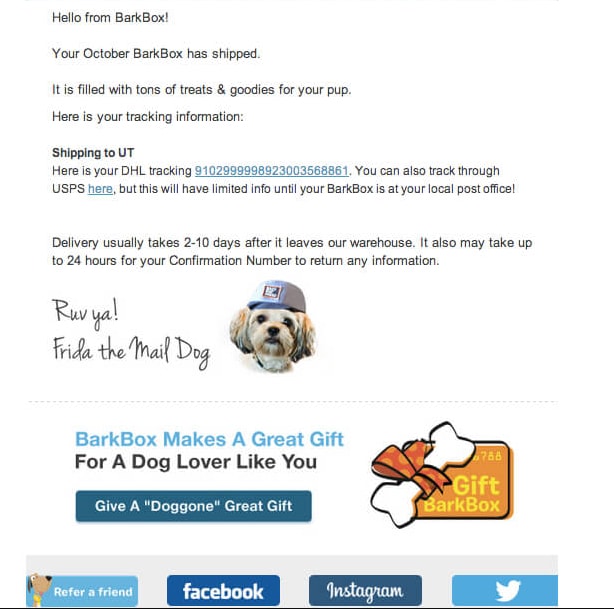
While recommendations at this stage can work, you should be careful about a few things.
- Recommendations should not be the first thing a customer sees
Order confirmation is supposed to be informational. Being able to recommend a few products is just a secondary bonus.
- Products should be relevant
Your recommendations should be personalized and relevant to what the customer bought.
For example, showing customers who bought a razor blade recommendations for swimwear is not going to bring people back to your site for second helpings.
- Prevent information overload
Again, order confirmation details should command most of the email real estate.
Limit your recommendations to no more than 5 in order to prevent information overload and drawing attention away from the main purpose of the email.
- The review us email
Editors Note: It’s against Yelp review policy to solicit reviews. To be in compliance with the Yelp platform, instead of asking for reviews, tell your customers “check us out on Yelp!”
Asking for a review helps you in many ways.
First off, you’re gaining valuable social proof that can be used to convince other potential customers to buy from you.
Back on the driving repeat purchases front, reviews provide a good excuse to check in with customers post-purchase and remind them you exist.
They also highlight your customer service.
If you know how, you can even provide an opportunity to set up a repeat purchase.
Check out this email from Warby Parker which calmly asks for a review.
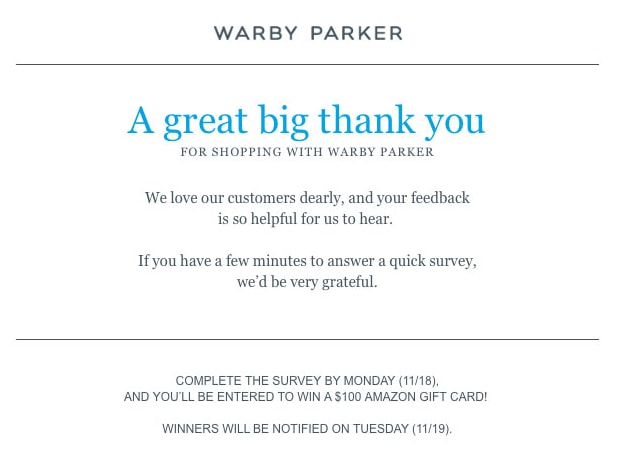
Here’s how to make the most of these emails:
- Timing matters
Send these emails a few days after customers receive their item.
The purchase experience is still fresh in their mind and this is the opportune moment to collect a glowing review.
- Appreciate their feedback
Let customers know their feedback is valued.
People feel obliged to reciprocate the kind of treatment they receive.
Telling customers their opinions matter increases the number of reviews you collect and drives a large share of them back to buy from you again.
- Give an incentive
This is the easiest way to invite a repeat purchase.
The idea is to make the customers feel they’re getting something in return for doing you a favor.
It just happens that a discount provides this feeling and drives customers back to your store to spend on you again.
2. Occasional customers
It’d be great if customers bought repeatedly and frequently.
As we know, this is the exception rather than the norm.
Most of your customers will be occasional. They might buy from you based on their needs every few months, seasonally or even every few years.
This group of customers is at risk of becoming unengaged.
To drive sales from this group of customers, your approach should be to remind them that you exist (brand awareness) and mix such messages with special promotions.
- The loyalty reward email
Customers like to feel exclusive and special.
It’s no coincidence that brands launch new products with a limited stock in order to make the first round of customers feel special (it also creates massive buzz).
You can mimic this with loyalty reward emails.
Provide a ‘special’ offer to your customers and mention why they have received it.
Dressabelle’s loyalty reward email hits all the right spots to bring back customers who are at risk of becoming disengaged from their brand entirely.
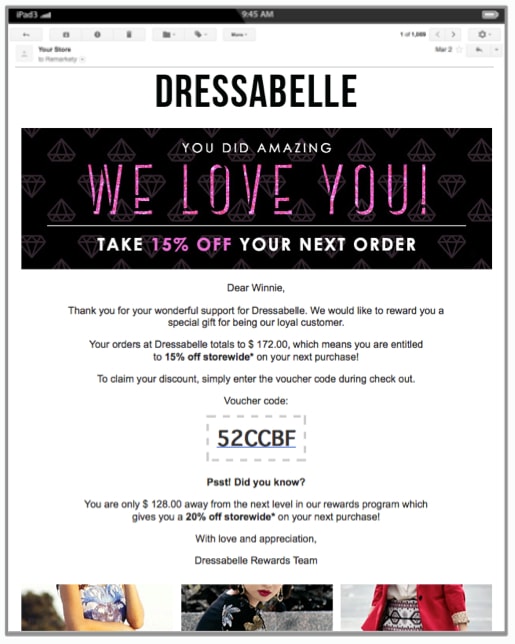
The ultimate goal of these emails is to make your customers feel like royalty and make sure they know how thankful you are for their business.
- The birthday email
Birthdays are a time of celebration and festivities.
Be a part of your customer’s celebration with your very own gift giving. This could be either be a mouth-watering deal or even a free gift.
Topshop’s birthday email has a great festive feel to it.
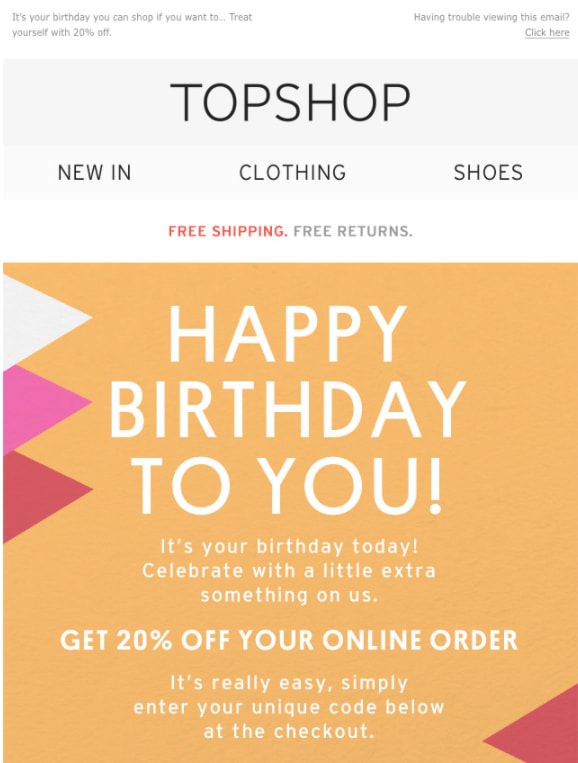
While crafting your birthday emails, keep these points in mind:
- Provide a ‘can’t resist’ coupon
This could be a flat fee off a customer’s next purchase, fixed % discount, free shipping, or even a free gift.
- Send the offer on their actual birthday
Sending the email on the exact day of a customer’s birthday works best.
Generally, most people will be overjoyed with the occasion and more open to spending even if it wasn’t their intent to visit your store.
- Send a reminder after their birthday
In case a customer was busy during their birthday, send them a gentle reminder to let them know they can still avail a great deal.
You don’t have to limit these festive emails to just birthdays.
There are many other occasions such as anniversaries and holidays that you can use to replicate this email type.
- Company update email
Just as when you were wooing this customer with your welcome series, the goal is to avoid being overly promotional.
If all these occasional customers see in their inbox from you are product recommendations and discounts, you’ll be seen as too profit-driven.
Sometimes, all you should really do is fill customers in on what’s new.
Let them know of about a new product under development, a product launch date, or even an upcoming event where you’ll be present.
Chick-Fil-A gets its customers thinking about their brand by hinting at something big without revealing exactly what it is.
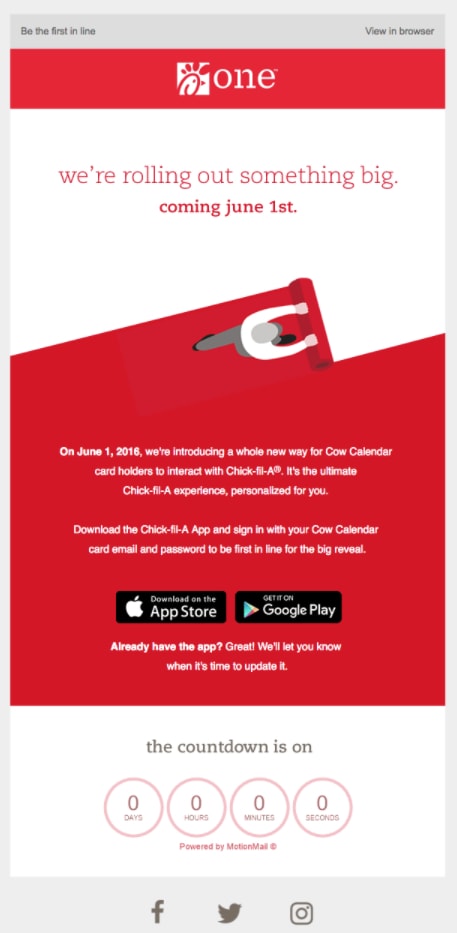
Stage 3 – Lapsed Buyers (Inactive)
Losing a few customers is expected.
It’s part of the process of running an eCommerce business. With that said, this shouldn’t be an excuse for not trying to win back customers who have become inactive or dropped off the radar.
There’s very little risk and a lot to gain.
How do you know which customers are lapsed?
Generally, if someone hasn’t opened an email or bought from you within a certain time frame, they are in the process of ‘lapsing.’
If you haven’t seen any activity well-past this period, consider a customer lost.
The reason for drop offs can be numerous.
- Their circumstance has changed
- They’ve switched to a new email account
- Had a bad experience with your brand
- Only bought from you because of a rare amazing deal
Since customers are sensitive to their reason, you need to create messaging that resonates with them to get them to reconsider buying from you.
Your first task is to segment at-risk customers into the following two categories:
- Lapsing – inactive customers at risk of being lost permanently
- Lapsed – customers who have forgotten about you
Consider creating an RFM matrix to help you visualize and segment customers.
- Recency from last order (in months) – the most important measure of customer health
- Frequency (number of orders in a year)
- Monetary value (low/med/high) – based on average order value
Here’s an example of how one looks (note: your time frame may look different).
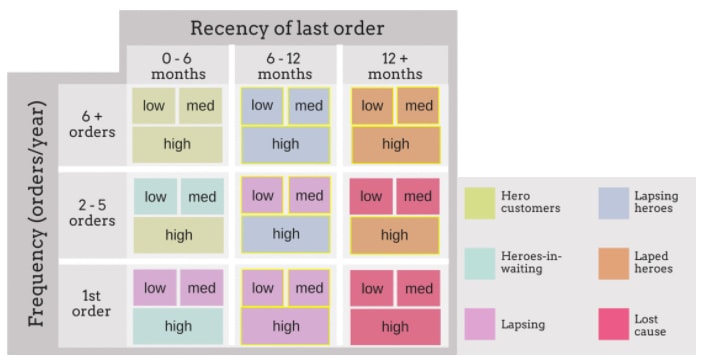
You’ll need to be more aggressive with lapsed customers than those deemed inactive.
- The emotional appeal email
Everyone likes to hear they are missed.
It makes them feel special and valued. Use this as a tactic to grab a customer’s attention, peak their curiosity and get them to open your email.
Use phrases such as ‘we miss you’ or ‘we’re sad when you are away’ in your subject line and email copy.
Once your email is opened, give an irresistible reason for readers to visit your site.
Pinkberry achieves this by giving its inactive users a freebie.
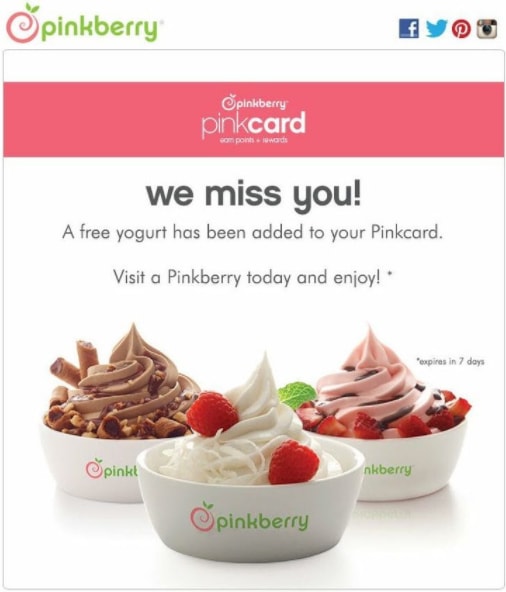
Since everyone loves free things, this works quite well.
If you’re unable to give away a small gift, you can provide discounts, thank customers for their business, or provide them updates about what they have missed while being away.
- The ‘Hail Mary’ discount email
If inactive customers still don’t bite, you’ll have to up the ante.
Up until now, you’ve used small discounts here and there to get interested and engaged customers to purchase from you.
Now, it’s time to pull out the heavy artillery.
Offer a discount so big that customers can’t help but act on it.
If you have to foot their bill, take the loss. Once they’ve been reacquainted with buying from you, they’ll end purchasing other items.
Missguided gives its inactive customers a mouth-watering offer.
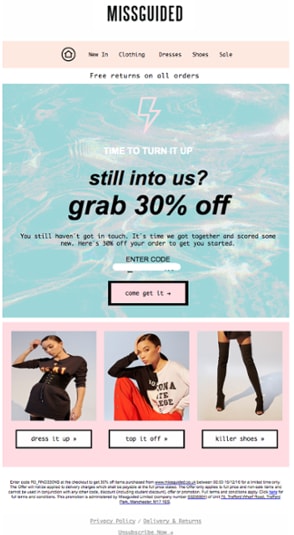
- The passive aggressive email
The previous emails may work on recently lapsed customers.
However, if someone has been inactive for a long time, they have likely forgotten about you. Sending them an emotional or promotional email out of the blue will probably get you marked as spam.
It’s time to be passive aggressive and let customers know they are about to be unsubscribed.
Ask them what you could have done better so that you can help other customers.
Remember to be gentle and unobtrusive like UrbanOutfitters does here.
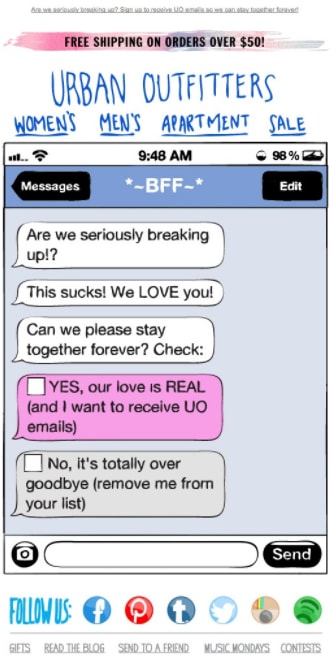
If customers are actually reading, they will feel guilty and take the necessary steps to stay on your list. This also brings your brand to the top of their mind.
If they truly don’t want anything more to do with you, at least you’ll get some valuable feedback.
- Time to let go
Sometimes you have to accept defeat.
If after all of your efforts to rre-engage your customer still won’t open your emails, it’s time to let go and unsubscribe them
Send them one final email notifying them of this terrible news. Leave them with a link they can use to get back on your list in case they change their mind.
Time to Get to Work
Take a deep breath.
You’ve just absorbed a lot of information that you’ll need to let sink in for a few moments.
If there’s one thing that you should absolutely take away from this guide, it’s that e-commerce emails should always deliver the right message at the right time.
Sending the same email to customers over and over just stunts your growth.
Take time to come up with a roadmap and create email campaigns that target customers along their entire lifecycle. Your bottom-line will thank you for it.
